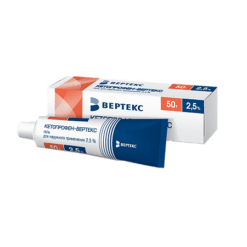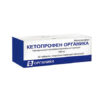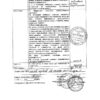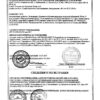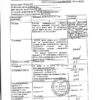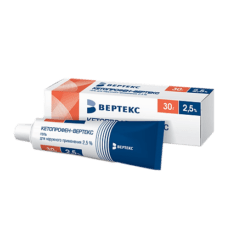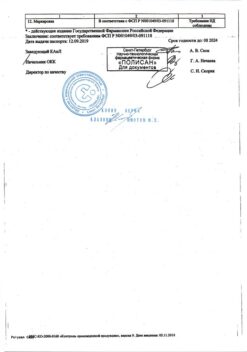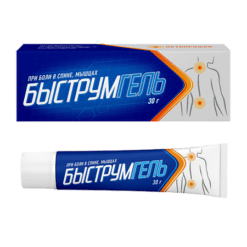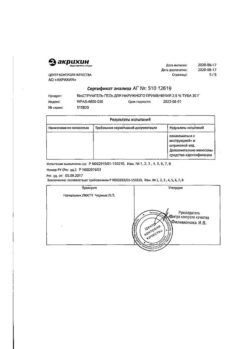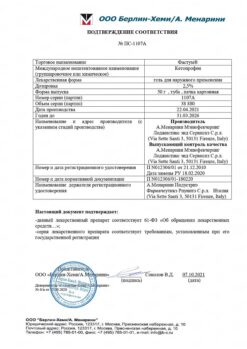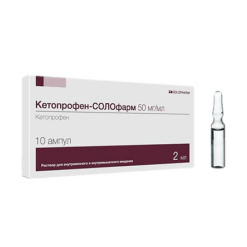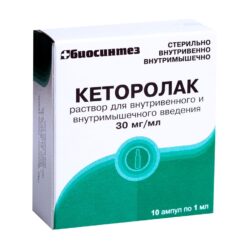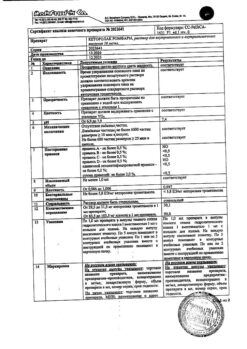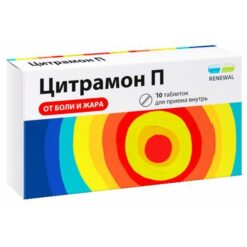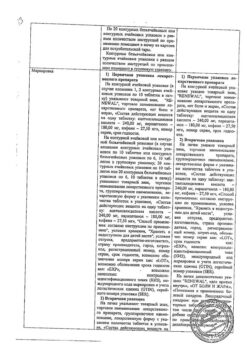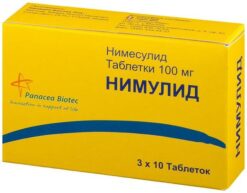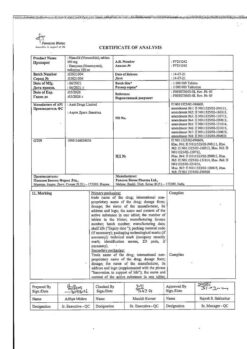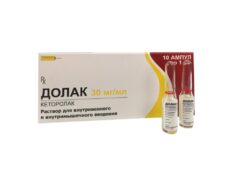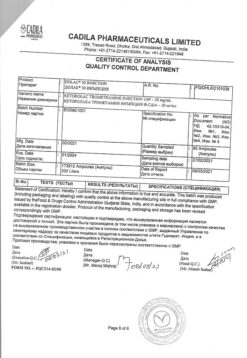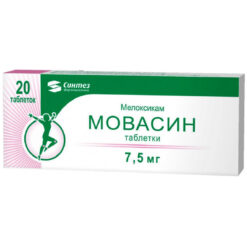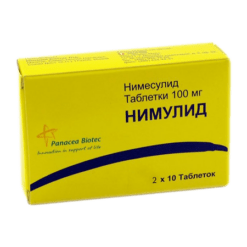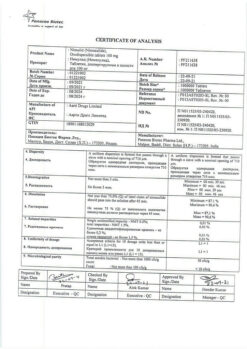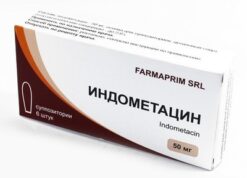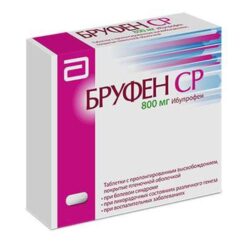Subtotal: €5.22
Ketoprofen, 100 mg 20 pcs.
€5.00 €4.42
Out of stock
(E-mail when Stock is available)
Absorption is fast, bioavailability is more than 90%. Binding to plasma proteins – 99%. TCmax – 1-2 hours after oral administration, 1.4-4 hours – when administered rectally, 15-30 minutes – when administered parenterally.
When taking retard tablets, the minimum effective concentration is determined after 45-60 min. Css in plasma is reached 24 h after the beginning of regular administration. Therapeutic concentration in synovial fluid is maintained for 6-8 h. It does not penetrate through the HEB in significant amounts.
It is almost completely metabolized in the liver by glucuronidation, has a “first pass” effect through the liver.
It is eliminated by the kidneys (mainly) and the intestines (1%). T1/2 – 1.6-1.9 hours – for regular tablets and 5.4 hours – for sustained-action tablets. It does not cumulate.
Ketoprofen lysine salt: TCmax after oral administration as granules – 15 min, when parenteral administration – 20-30 min, when rectal administration – 45-60 min. Effective concentration is reached after 20-30 min and retained for 24 h. Therapeutic concentration in synovial fluid is retained for 18-20 hours.
It is metabolized by microsomal liver enzymes. It is excreted by the kidneys, 60-80% – as glucuronide in 24 hours.
Indications
Inflammatory and degenerative diseases of the musculoskeletal system: rheumatoid, psoriatic arthritis, ankylosing spondylitis (ankylosing spondylitis), gouty arthritis (in case of an acute attack of gout, fast-acting dosage forms are preferred), osteoarthritis.
Intended for symptomatic therapy, reducing pain and inflammation at the time of use, does not affect the progression of the disease.
Pain syndrome: myalgia, ossalgia, neuralgia, tendonitis, arthralgia, bursitis, radiculitis, adnexitis, otitis media, headache and toothache, in cancer, post-traumatic and postoperative pain syndrome accompanied by inflammation.
Algodysmenorrhea, childbirth (as an analgesic and tocolytic agent).
Pharmacological effect
Absorption is fast, bioavailability is more than 90%. Communication with plasma proteins – 99%. TCmax – 1-2 hours after oral administration, 1.4-4 hours – with rectal administration, 15-30 minutes – with parenteral administration.
When taking retard tablets, the minimum effective concentration is determined after 45-60 minutes. Css in plasma is achieved 24 hours after the start of regular use. The therapeutic concentration in the synovial fluid lasts 6-8 hours. It does not penetrate the BBB in a significant amount.
Almost completely metabolized in the liver by glucuronidation, has a “first pass” effect through the liver.
Excreted by the kidneys (mainly) and intestines (1%). T1/2 – 1.6-1.9 hours – for regular tablets and 5.4 hours – for extended-release tablets. Does not cumulate.
Lysine salt of ketoprofen: TCmax after oral administration in the form of granules – 15 minutes, with parenteral administration – 20-30 minutes, with rectal administration – 45-60 minutes. The effective concentration is achieved after 20-30 minutes and persists for 24 hours. Therapeutic concentration in synovial fluid persists for 18-20 hours.
Metabolized by microsomal liver enzymes. Excreted by the kidneys, 60-80% – in the form of glucuronide in 24 hours.
Special instructions
During treatment, monitoring of the peripheral blood picture and the functional state of the liver and kidneys is necessary. If it is necessary to determine 17-ketosteroids, the drug should be discontinued 48 hours before the study.
Taking ketoprofen can mask the signs of an infectious disease.
If renal or liver function is impaired, dose reduction and careful monitoring are necessary.
Impact on the ability to drive vehicles and operate machinery. During the treatment period, care must be taken when driving vehicles and engaging in other potentially hazardous activities that require increased concentration and speed of psychomotor reactions.
Active ingredient
Ketoprofen
Composition
1 film-coated tablet contains:
active ingredient:
ketoprofen 100 mg,
excipients:
hyprolose (Klucel LF) – 2.4 mg;
mannitol (D-mannitol) – 21 mg;
croscarmellose sodium (primellose) – 5.4 mg;
MCC – 48.4 mg;
colloidal silicon dioxide (Aerosil) – 1 mg;
magnesium stearate monohydrate – 1.8 mg,
film shell:
Opadry II white (polyvinyl alcohol – 4 mg, titanium dioxide – 2.5 mg, macrogol (polyethylene glycol) – 2.02 mg, talc – 1.48 mg) – 10 mg
Contraindications
hypersensitivity to ketoprofen (including other NSAIDs);
Crohn’s disease;
peptic ulcer of the stomach and duodenum (exacerbation);
diverticulitis;
blood clotting disorders, incl. hemophilia;
chronic renal failure;
pregnancy (III trimester);
children’s age (up to 6 years).
hypersensitivity to other components of the drug and salicylates;
severe heart failure;
treatment of postoperative pain during coronary artery bypass surgery;
chronic dyspepsia;
active peptic ulcer or ulceration/perforation;
gastrointestinal, cerebrovascular or other bleeding, patients prone to hemorrhage;
severe liver or kidney dysfunction;
bronchial asthma;
a history of rhinitis or urticaria caused by taking acetylsalicylic acid or other NSAIDs;
lactation period.
With caution: anemia; bronchial asthma; alcoholism; smoking; alcoholic cirrhosis of the liver; hyperbilirubinemia; liver failure; chronic renal failure (Cl creatinine 30–60 ml/min); history of ulcerative lesions of the gastrointestinal tract; presence of Helicobacter pylori infection; long-term use of NSAIDs; diabetes mellitus; dehydration; sepsis; chronic heart failure; swelling; arterial hypertension; blood diseases (including leukopenia); stomatitis; coronary heart disease; cerebrovascular diseases; dyslipidemia/hyperlipidemia; peripheral arterial disease; severe somatic diseases; simultaneous use of oral corticosteroids (including prednisolone), anticoagulants (including warfarin), antiplatelet agents (including clopidogrel), SSRIs (including citalopram, fluoxetine, paroxetine, sertraline); old age; pregnancy (I and II trimester)
Side Effects
The frequency is classified as rare – from 0.01 to 0.1%; very rarely –
From the digestive system: NSAID gastropathy, abdominal pain, dyspepsia (nausea, vomiting, heartburn, flatulence, loss of appetite, diarrhea), stomatitis, impaired liver function; rarely – erosive and ulcerative lesions, bleeding and perforation of the gastrointestinal tract, changes in taste.
From the nervous system: headache, dizziness, insomnia, agitation, nervousness, drowsiness, depression, asthenia; rarely – confusion or loss of consciousness, forgetfulness, memory impairment, migraine, peripheral neuropathy.
From the senses: noise or ringing in the ears, blurred vision; rarely – conjunctivitis, dry mucous membrane of the eye, eye pain, conjunctival hyperemia, hearing loss, dizziness; additionally for capsules – vertigo.
From the cardiovascular system: edema, increased blood pressure; rarely – tachycardia.
From the respiratory system: hemoptysis, shortness of breath, pharyngitis, rhinitis, bronchospasm, laryngeal edema (signs of an anaphylactic reaction); rarely – asthma attacks.
From the hematopoietic organs: rarely – agranulocytosis, anemia, hemolytic anemia, thrombocytopenia, leukopenia. High doses of ketoprofen can inhibit platelet aggregation, thereby prolonging bleeding time, and cause epistaxis and hematoma formation.
From the urinary system: edema syndrome; rarely – cystitis, urethritis, renal dysfunction, interstitial nephritis, nephrotic syndrome; rarely – hematuria.
From the immune system: reactivity of the respiratory system, including bronchial asthma, its exacerbation; bronchospasm or shortness of breath (especially in patients with hypersensitivity to acetylsalicylic acid and other NSAIDs); very rarely – angioedema and anaphylaxis.
Allergic reactions: skin rash (including erythematous, urticaria), skin itching, rhinitis; rarely – exfoliative dermatitis.
Other: increased sweating; rarely – hemoptysis, nosebleeds, myalgia, muscle twitching, shortness of breath, thirst, photosensitivity; with prolonged use in large doses – vaginal bleeding.
Laboratory indicators: very often – deviation from the norm in liver function tests.
Interaction
Reduces the effectiveness of uricosuric drugs, enhances the effect of anticoagulants, antiplatelet agents, fibrinolytics, ethanol, side effects of corticosteroids and mineralocorticosteroids, estrogens; reduces the effectiveness of antihypertensive drugs and diuretics.
Combined use with other NSAIDs, corticosteroids, ethanol, corticotropin can lead to the formation of ulcers and the development of gastrointestinal bleeding, increasing the risk of developing renal dysfunction.
Co-administration with oral anticoagulants, heparin, thrombolytics, antiplatelet agents, cefoperazone, cefamandole and cefotetan increases the risk of bleeding.
Increases the hypoglycemic effect of insulin and oral hypoglycemic drugs (dose recalculation is necessary).
Inducers of microsomal oxidation in the liver (phenytoin, ethanol, barbiturates, rifampicin, phenylbutazone, tricyclic antidepressants) increase the production of hydroxylated active metabolites.
Co-administration with sodium valproate causes disruption of platelet aggregation.
Increases plasma concentrations of verapamil and nifedipine, lithium preparations, methotrexate.
Antacids and cholestyramine reduce absorption.
Myelotoxic drugs enhance the manifestations of hematotoxicity of the drug.
With the simultaneous administration of ketoprofen and loop diuretics, the nephrotoxic effect of both drugs is enhanced.
Overdose
Cases of drug overdose have not been described.
Treatment: symptomatic, there is no specific antidote for the drug.
Storage conditions
In a place protected from light, at a temperature not exceeding 30 °C.
Shelf life
2 years.
Manufacturer
Organika, Russia
| Shelf life | 2 years. |
|---|---|
| Conditions of storage | In the dark place at a temperature not exceeding 30 °C. |
| Manufacturer | Organika, Russia |
| Medication form | pills |
| Brand | Organika |
Other forms…
Related products
Buy Ketoprofen, 100 mg 20 pcs. with delivery to USA, UK, Europe and over 120 other countries.

